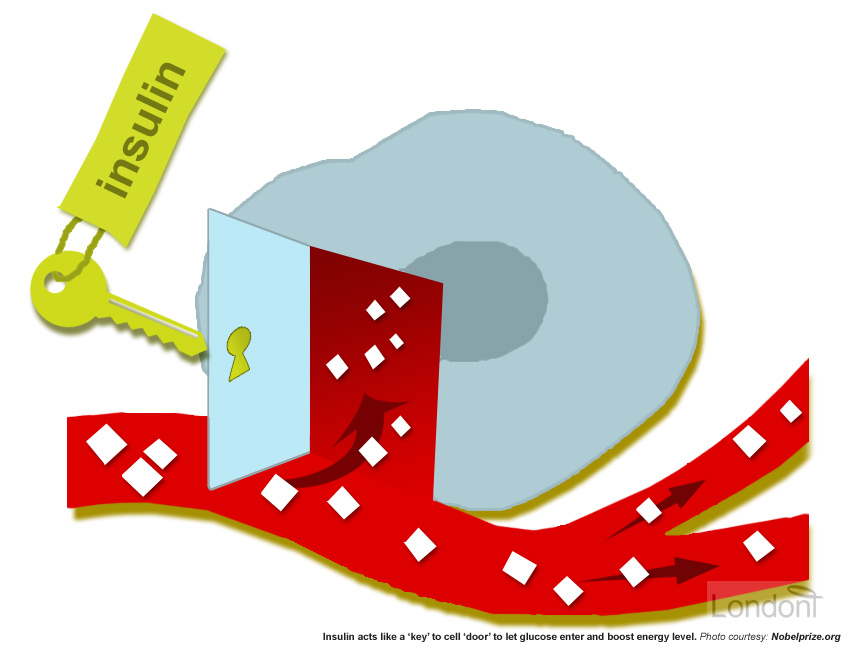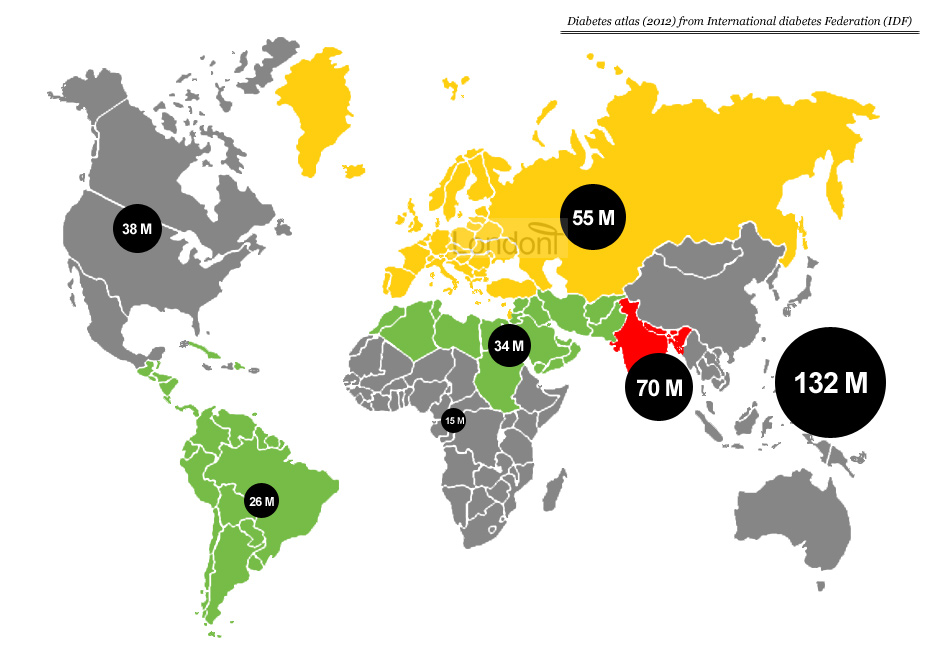
What is diabetes?
Diabetes is a lifelong condition that causes a person's blood sugar level to become too high because the body cannot use it properly. At present, diabetes cannot be cured - but can be managed.
Diabetes is responsible for over 4 million deaths each year. Every 7 seconds someone dies from diabetes-related causes. It kills more people than breast and prostrate cancer combined and every 3 minute one person is diagnosed with this "silent epidemic".
Glucose & insulin
Our body uses blood sugar, known as 'glucose', as its main source of energy. This provides us with the 'fuel' we need to carry on with our daily activities of work, play and generally live our lives. It is vital for life.
Glucose is a basic ingredient of sweet foods such as sweets and cakes. It can also be produced by carbohydrates such as potatoes, pasta or bread when they are digested and broken down. Glucose is also produced by our liver. If, however, we have too much glucose in the blood it becomes toxic. So we need something to manage it - this is done by insulin.
Inside our body, located behind the stomach, is the pancreas. This organ produces a hormone called 'insulin' which carefully regulates how much glucose is in the blood. Insulin moves the glucose out of our blood and into the cell so it can provide us with the energy we need. Thus our body needs insulin to transform glucose into energy.
The cells are like locks and insulin are the keys - they open the lock for the glucose to enter. Diabetes occur when we cannot control our glucose level because of problem with these keys. The keys may not exist, or there may not be enough keys to open the cells, or the keys may not work properly (known as 'insulin resistance'). Therefore glucose builds up in our blood and cannot be used as fuel. This can cause serious damage to our organs.
After a meal, the amount of glucose in your blood rises, which triggers the release of insulin. When blood glucose levels fall, during exercise for example, insulin levels fall too.

Type of diabetes
There are two main types of diabetes:
- Type 1 diabetes
- Type 2 diabetes
Both Type 1 and Type 2 diabetes are serious. There is no such thing as mild diabetes.
'Type 1'
Type 1 diabetes occur when the pancreas does not produce any insulin (i.e. no keys are made for the locks). The body's immune system attacks and destroys the cells that produce insulin. It's not fully understood why this occurs. Now, with no insulin to control it, the glucose level increases, which can seriously damage the body's organs.
Type 1 diabetes is an autoimmune condition, where your immune system (the body's natural defence against infection and illness) mistakes the cells in your pancreas as harmful and attacks them.
Without insulin, the body breaks down its own fat and muscle (leading to weight loss). In type 1 diabetes this can lead to a serious short-term condition where the bloodstream becomes acidic along with dangerous dehydration (diabetic ketoacidosis).
If you're diagnosed with Type 1 diabetes, you will need to take insulin injections for the rest of your life and as such Type 1 diabetes is often referred to as 'insulin-dependent' diabetes. It is also sometimes known as 'juvenile diabetes' or 'early-onset diabetes' because it often develops before the age of 40, usually during the teenage years. However, it can still affect people of other age.
You must also make sure that your blood glucose levels stay balanced by eating a healthy diet, taking regular exercise and having regular blood tests.
Type 1 diabetes is less common than Type 2 diabetes. About 10% of all people with diabetes have Type 1 diabetes.
'Type 2'
Type 2 diabetes occur when the body does not produce enough insulin (i.e. not enough keys are made for the locks and as such referred to as 'insulin deficiency'), or the body's cells do not react to it (i.e. keys don't work properly, referred to as 'insulin resistance').
If you are diagnosed with Type 2 diabetes, you may be able to control your symptoms simply by eating a healthy diet and monitoring your blood glucose level. However, as Type 2 diabetes is a progressive condition, you may eventually need medication, usually in the form of tablets.
Type 2 diabetes is far more common than Type 1 diabetes. Around 90% of all adults with diabetes have Type 2 diabetes. The number of people with type 2 diabetes is increasing in every country.
Type 2 diabetes used to be called non-insulin dependent diabetes or adult-onset diabetes, and accounts for at least 90% of all cases of diabetes. It is characterised by insulin resistance and relative insulin deficiency, either or both of which may be present at the time diabetes is diagnosed.
The diagnosis of type 2 diabetes can occur at any age. Type 2 diabetes may remain undetected for many years and the diagnosis is often made when a complication appears or a routine blood or urine glucose test is done.
Other types...
There are three other, less common, forms of diabetes:
- Gestational diabetes (in pregnancy) = During pregnancy, some women have such high levels of blood glucose their body is unable to produce enough insulin to absorb it all. This is known as gestational diabetes and can increase the risk of health problems developing in an unborn baby, so it is important to keep your blood glucose levels under control. In most cases, gestational diabetes develops during the second trimester of pregnancy (weeks 14-26) and disappears after the baby is born. However, women who have gestational diabetes are at increased risk (30%) of developing type 2 diabetes later in life (compared to a 10% risk for the general population).
- Neonatal diabetes = This is very rare. It is caused by a change in a gene that affects insulin production.
- Maturity onset diabetes of the young (MODY) = Caused by a mutation in a single gene and is also very rare.
In the UK, diabetes affects approximately 2.9 million people. There are also thought to be around 850,000 people with undiagnosed diabetes.

How do I know if I've got diabetes?
The main symptoms of diabetes are:
- Feeling very thirsty
- Urinating frequently, especially at night
- Feeling very tired
- Weight loss and loss of muscle bulk
- Genital itching or regular episodes of thrush
- Slow healing of cuts and wounds
- Blurred vision
In Type 1 diabetes the signs and symptoms are usually very obvious and can develop quickly, over weeks or even days. In Type 2 diabetes the signs and symptoms may not be so obvious, as the condition develops slowly over a period of years so people may have Type 2 without realising it. In both instances, the symptoms are quickly relieved once diabetes is treated and under control.
Who's more likely to get diabetes?
You are more at risk of developing Type 2 diabetes if:
- You are over 40 (or over 25 if you are South Asian).
- You have a close family member with diabetes (parent, brother or sister).
- You are overweight, with a large waist size (over 80cm or 31.5 inches for women, 94cm or 37 inches for men, or 89cm or 35 inches for South Asian men).
- Being South Asian, Black African, African Caribbean - even if you were born in the UK.
- You have ever had high blood pressure, a heart attack or a stroke.
- You're a woman with polycystic ovary syndrome and overweight.
- If you're a woman and you've had gestational diabetes or given birth to a baby over 10 pounds.
- If you have a severe mental illness for which you take medication (such as schizophrenia, bipolar illness or depression).
- You've been told you have impaired glucose tolerance or impaired fasting glycaemia.
Some of these risks factors are genetic factors and there is little you can do to reduce them, so it's best to concentrate on those you can change, such as your weight.
The risk factors for Type 1 diabetes are still being researched. However, having a family member with Type 1 diabetes slightly increases the risk of developing the disease. Environmental factors and exposure to some viral infections have also been linked to the risk of developing Type 1 diabetes.
Check quickly online
You can carry out a quick self-assessment online with the UK Government's National Health Service (NHS). The website address is: http://www.nhs.uk/conditions/Diabetes-type2/Pages/Introduction.aspx.
The self-assessment takes less than 2 minutes to complete.
Next step...
Getting the most out of your doctor appointments
Before the appointment:
- Decide what you need to know.
- Write down the points you want to raise.
- Bring your blood glucose meter and results record with you, if you test.
- Bring any news features/stories or research that you have any questions about.
During the appointment:
- Listen actively – ask questions, give feedback and ask for clarification if you’re unsure of anything.
- Make notes to help you remember what has been said.
- Check you’ve covered your list
After the appointment:
- Review what's been said and agreed.
- Make a note of anything you need to do before your next appointment.

Worldwide epidemic
Diabetes is a global killer. Currently, over 300 million people - IDF estimates 382 million while WHO estimates 347 million - are living with diabetes. This total is set to rise to 592 million by 2035. That is, in 20 years time over half a billion people will have diabetes. The reality is, with many people still undiagnosed, the numbers will be much higher and many more are at risk of the disease.
Some shocking statistics on diabetes from World Health Organisation (WHO):
- 347 million people worldwide have diabetes.
- In 2004, an estimated 3.4 million people died from consequences of high fasting blood sugar.
- More than 80% of diabetes deaths occur in low- and middle-income countries.
- WHO projects that diabetes will be the 7th leading cause of death in 2030.
Diabetes has correctly been labeled as the "silent epidemic" - its non-dramatic, insidious and chronic nature often masks the menace inflicted by the disease through death, incapacitation, and negative impact on quality of life of patients as they spend years coping with their life-changing affliction.
Hope4Diabetes website
Top 20 countries (in 2013)
| Country | Cases |
|---|---|
| 1. China | 98,407,000 |
| 2. India | 65,076,000 |
| 3. USA | 24,402,000 |
| 4. Brazil | 11,934,000 |
| 5. Russia | 10,924,000 |
| 6. Mexico | 8,723,000 |
| 7. Indonesia | 8,554,000 |
| 8. Germany | 7,560,000 |
| 9. Egypt | 7,511,000 |
| 10. Japan | 7,204,000 |
| 11. Turkey | 7,043,000 |
| 12. Pakistan | 6,713,000 |
| 13. Bangladesh | 5,089,000 |
| 14. Iran | 4,396,000 |
| 15. Nigeria | 3,922,000 |
| 16. Spain | 3,791,000 |
| 17. Saudi Arabia | 3,651,000 |
| 18. Italy | 3,626,000 |
| 19. France | 3,375,000 |
| 20. Republic of Korea | 3,324,000 |
Source: International Diabetes Federation (IDF)
In every country and in every community worldwide, we are losing the battle against this cruel and deadly disease.
Jean Claude Mbanya, President of IDF (2011)

Famous people with diabetes
People often think that Type 2 diabetes strikes only the overweight and unhealthy eaters. And though factors such as obesity, genetic predisposition, race, and age do heighten the chances, anybody can be diagnosed with this disease. Even world-class athletes, or the rich and famous. No population or age group is spared by the epidemic.
The following celebrities were diagnosed with Type 2 diabetes:
- Hollywood acting moghul Elizabeth Taylor
- British rower and 5-times Olympics gold winner Steve Redgrave
- Former world no.1 tennis player and winner of 39 Grand Slam title Billie Jean King
- Multiple Oscar winning actor Tom Hanks
- Star Wars creator George Lucas
- CNN anchor Larry King
- Oscar winning actress Halle Berry
- Bollywood actress, and daughter of Anil Kapoor, Sonam Kapoor
- American music producer Randy Jackson
In addition, Pakistani cricketing legend Wasim Akram, South Indian acting superstar Kamal Hassan and professional English football player Gary Mabbutt are known to suffer from Type 1 diabetes, whilst Hollywood acting beauty Salma Hayek had been diagnosed with gestational diabetes.
Although all had some risk factors for diabetes (such as weight, ethnicity, or family history), many were still shocked to hear the diagnosis. They’ve all made healthy changes in their lives, and many now speak out about the dangers of diabetes.
It is possible for those who lead seemingly healthy lives to be diagnosed with the disease. As these celebrities show, despite outward appearance, athleticism, money, or fame, Type 2 diabetes can affect anyone.
Eloise Porter, Writer
Diabetes caught me completely off guard. None of my family had suffered from the illness and although I was slightly overweight in school, I thought I was pretty healthy. I fell ill - dramatically - when I was on the TV show, Living Dolls, in 1989. I felt I needed energy but I didn't even have a minute to pop out and get a chocolate bar. I didn't really know what was wrong. I thought I could tough it out, but I couldn't have been more wrong. One day, I simply passed out, and I didn't wake up for seven days, which is obviously very serious.
They told me I might lose my eyesight, or I could lose my legs. I was scared to death, I thought I was going to die. I went into hospital on my last breath, and came out feeling a hundred times better. I knew it was time to take better care of myself and I can honestly say that I am a healthier person than I was before I was taken ill.
I started to eat loads of wonderful fresh vegetables, chicken, fresh fish and pasta. I cut out red meat and cut back on fruit because it can contain quite a lot of sugar. Now one of my favourite dishes is something simple but tasty such as grilled tuna and garlic mashed potato.
I needed to pay attention of everything that could affect my blood sugar level, including diet exercise and stress. I have to test my blood sugar levels at least a couple of times a day. I do a tiny pinprick, usually on my fingertips, and test it with a special kit which tell me how high or low my blood sugar levels are. Then using this as a guide I inject myself with the correct dose of insulin to level up my blood sugar. People always kind of cringe when I say that [laughs]. Actually I feel very lucky that I can take insulin. It saves me from becoming ill.
Diabetes turned out to be a gift. It gave me strength and toughness because I had to face reality, no matter how uncomfortable or painful it was.
Oscar-winning actress Halle Berry on having Type 2 diabetes "gift"
I got gestational diabetes, which I didn't realize at first. It occurs in women who have high blood sugar levels during pregnancy. I didn't know whether I was feeling bad because I was pregnant or whether something was seriously wrong. I was nauseated for nine months, which can be one of the symptoms.
Just know that you can live a normal, wonderful, terrific, active life. Every person I know who has diabetes has actually gotten a lot of good from it. They're still very excited about living and want to do more with their life sometimes because of it.
Tennis champion Billie Jean King's assuring message to fellow diabetes sufferers
I remember what a shock it was because I was a healthy sportsman with no history of diabetes in my family, so I didn't expect it at all. It seemed strange that it happened to me when I was 30, but it was a very stressful time and doctors said that can trigger it.
I lost 8kg in a little over two months, but I put it down to hard training, drinking lots of water and sleeping a lot. I faced the West Indies in that condition. My father and my wife insisted I go to the doctor and he found my sugar level was sky-high.
I felt down [depressed] at first but my wife, who qualified as a psychiatrist at UCL, helped me come to terms with it. I would advise anyone with diabetes to think positively. Adjust your lifestyle to fight it. Keeping fit and eating a very balanced diet have been crucial to keeping it under control and allowing me to continue playing. If you have control of your body, you're in control of diabetes. It's important to check blood sugar levels before meals and go for regular check-ups.
Obviously I'm resting a bit more at home now rather than living out of a suitcase. I still like to keep fit by playing with my kids and I play a lot of golf. I'm 38 now so I've been managing what I eat for almost eight years and it’s become part of my daily routine.
It's important that parents help their kids eat well and keep active, rather than watching TV and eating sweets.
Wasim Akram was 30 years old when he was diagnosed with insulin-dependent diabetes (2004)
